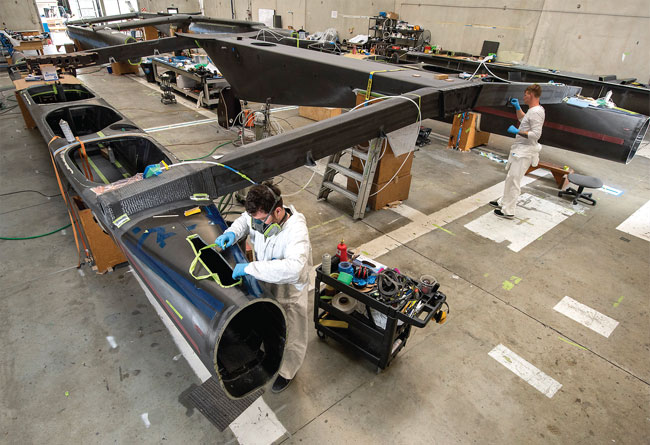
Many people have tried, including several of those involved in the latest initiative, to deliver a professional and engaging sailboat race circuit. But teams don’t come better qualified than this one and Act 1 in Bermuda was none too shabby. A good time to build on it then… James Boyd grills Russell Coutts about SailGP
Eleven and a half years ago, a few months before the 32nd America’s Cup in Valencia, the press were invited to Lisbon to hear from Russell Coutts and Paul Cayard about a new sailing circuit called the World Sailing League, backed to the tune of 30 million euros by a Portuguese sports promoter. The circuit would be a global series of grand prix, in 70ft one-design VPLP-designed catamarans with a US$5million prize purse. Given that at the time we were supposed to be getting excited about the latest Version 5 leadmines soon to be unveiled in Valencia, this new circuit for ultra-fast boats, supported by two of the biggest names in sailing, was a breath of fresh air.
Sadly the World Sailing League never materialised and it is perhaps for this reason that one of the worst-kept secrets in modern-day sailing is only being formally revealed now, just four months out from its first event.
Thanks to the entity formerly known as ISAF changing its name to World Sailing, ‘World’ was no longer an option and Coutts’s new circuit is to be called SailGP. The boats will be fully one-design, heavily enhanced versions of the AC50 flying catamarans and have been christened F50.
As a magnificent example of how multihull technology has sprinted through this past decade – while the World Sailing League’s 70ft cats were expected to hit top speeds of 30kt+, the new fully flying F50s will have a top speed in the mid-50s and will sail upwind at 30kt+, with the fully flying tacks and entirely airborne laps occasionally seen in Bermuda commonplace. But most importantly this circuit will definitely happen as it is being underwritten for the first three years by Larry Ellison.
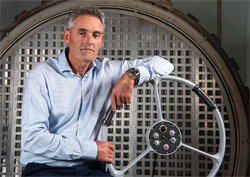
Main picture: in most cases Tim Smyth and Mark Turner’s team at Core Composites were able to use large parts of the four 2017 AC50s they secured from previous Cup teams including much of the central section of the hulls but with new stern sections grafted on. From there on, however, almost everything was new. Although there have been a few false starts, it’s relevant to remember in the context of the new series that Coutts (above) already has the RC44 tour on his CV as a successful sailing start-up. Load-testing the first F50 foils (below): it’s reasonably important to check you’ve got the engineering right before you start building 12 large foils… plus spares
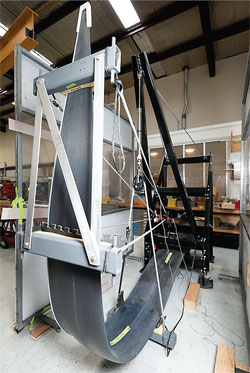
‘For Larry Ellison and myself, we have been thinking about bringing more certainty to a professional sailing league,’ explains Coutts, although in reality it is the fruits from probably two decades of his contemplation.
‘SailGP will offer annual, year-round, nation-versus-nation racing in different venues around the world with consistency in terms of format, venues, rules, teams and so on. That consistency will make it more of a longterm venture in terms of planning, increasing its commercial viability.’
In fact, the very things the America’s Cup traditionally lacks; the very things the ‘America’s Cup Framework Agreement’ of January last year hoped to rectify.
Importantly, Ellison is backing SailGP in its entirety, ie not just the circuit, the event and all the infrastructure, but the boats and teams too. While it gets up and running SailGP will properly be the Larry and Russell show. Coutts explains: ‘All the advice indicated that the reason a lot of new sports leagues don’t work is because they have a mix of owners and there are always disputes over how the thing should run, who should pay for what and how it should be marketed, etc. In my experience to get agreement between six different owners is incredibly difficult.’ Sound familiar? ‘We have structured this so we can make the major decisions in a more efficient way.’
In fact, owning the teams initially too may have been a late development as over the past year there were rumours of involvement from America’s Cup teams unwilling to compete in New Zealand, plus the likes of Red Bull and even Alinghi. However, instead SailGP teams will be named after nations or derivations (GBR might be British Bulldogs, for example). In year one, 2019, these nations will be GBR, Australia, USA, France, China and Japan.
At the time of writing the sole team announced are the Brits, to be led by Prada alumnus Chris Draper. He on this occasion will be wing trimmer while Dylan Fletcher steers and his Olympic 49er crew, 470 silver medallist Stuart Bithell is on flight control, augmented by grinders Richard Mason and Matt Gotrel. You will note that the new F50 have one crew fewer than the AC50s had in Bermuda.
Coutts says crew nationality restrictions will be tougher than ever seen previously. SailGP is working with World Sailing over the most precise way to define this. Clearly a potential problem is trying to have a national crew where that nation lacks adequate foiling catamaran experience. To address this the China and Japanese crews will receive special dispensation and will build to full nationality over the first three years – 40 per cent in season one, 60 per cent in season two, 80 per cent in season three, and 100 per cent by season four.
Coutts intends that teams are set up so that they have longevity, enabling them to build brand equity in the same way as top football teams have managed in Europe or NFL and NBA teams in the USA. ‘If an owner tires of being involved with a team, that team can be traded or sold and hopefully will continue existing. Usually sailing teams get set up, run and then disappear. We want to change that.’
Team budgets are expected to be around US$5million per annum, constrained to some degree by a personnel cap of 18. While we can certainly expect it to expand in every way in seasons to come – the ideal size for SailGP is mooted as being around 10 teams and 10 events annually – for 2019 there will be six teams (the maximum number of boats that could be created in the timeframe) and five events.
In the first season these will be:
- Australia in February
- San Francisco in May
- New York in June
- Cowes (during Cowes Week) in August
- Grand finale in Marseille in September
Events will all be two days long (Friday- Saturday or Saturday-Sunday), save for Marseille which will be three. Generally the race format will comprise five fleet races with the top two going into a final match-race.
Races will be short – typically of no more than 20 minutes’ duration.
The Marseille finale will end with a oneoff ‘all or nothing’ match-race between the top two teams, with a trophy… and US$1million on the line.
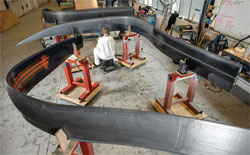
And what of the boats?
The America’s Cup has a long legacy of expensive, highly developed hardware ending up on the scrap heap after one or occasionally two Cups. With this in mind, SailGP has upcycled components from the AC50s used last year in Bermuda.
Many AC50 parts were close to being one-design, with the exception of the engineering and control systems for the wing and the design and control systems for the foils. However, ‘close to being one-design’ and being 100 per cent one-design are two very different things, as Mike Drummond and the 110-person team at Core Builders Composites in Warkworth, New Zealand, tasked with transforming the boats, will attest. For a start each AC50 together with its rig was built by a different manufacturer – albeit to the same outline design.
To get SailGP up and running for its first season, Core was commissioned to create six identical boats using many components from the Oracle, SoftBank, Artemis and BAR AC50s, with two more boats built from scratch using the Oracle tooling.
While the AC50 cross beams, centre pods and wings have been reused, the hulls have undergone major surgery to incor - porate new deck layout, board cases, systems, rudders, sterns, electronics and hydraulics. ‘The crash bows are the same,’ quips Coutts. ‘Having the old boats saved some time – we kept parts of the hull – but it wasn’t a huge amount.
‘We have built six new boats effectively.’ But importantly they are a big step on: ‘They will be incredible machines. The difference in the electronics and hydraulics now – it’s like looking at a spaceship.’
One of the major changes was reconfiguring the cockpit for five crew rather than six. So why one less? ‘We didn’t like the fact that the grinders were just pumping oil around the boat in Bermuda – that seemed pretty senseless,’ admits Coutts.
‘Now we have got a control system for the pitch control, the wing twist and the jib sheet which will be powered by battery. The two grinders will primarily control the wing sheet.’
As on the AC50s, the helmsman will have a steering wheel fitted with six buttons and a dial to control functions such as ride height. Meanwhile, the wing trimmer will control wing camber and twist and the jib sheet, plus there will be a dedicated ‘flight controller’ operating the foils by joy stick.
The boats are getting a whole new foil package to replace the AC50 foils optimised for Bermuda. This will comprise two sets of main lifting foils – light airs and high speed – plus new rudders and elevators. The reason for this, says Coutts, is that the new F50 will be 10-15 per cent faster across the board, also performing better in light winds and with a lower wind speed required for take-off.
The staggering 54kt top speed that is predicted, possible in just 20kt of breeze, has been achieved by raising the speed at which the foils start to cavitate, explains Coutts. ‘Pretty much all of the foils in Bermuda cavitated in the low 40s boat speed. With this both the light-air foils and the high-speed foils will see the onset of cavitation start at around 48kt which takes you well into the 50kt range before it becomes an issue.’
This hike has been achieved primarily by using a higher-modulus carbon fibre and improving the geometry of the foils. Even the new light-air foils will cavitate at a higher speed than the speed at which the AC50 heavy-air foils were beginning to ‘bubble’ in Bermuda last year.
Significantly, the pitch control of the rudders is also now active. ‘Before, when you adjusted the foil you adjusted the fore and aft balance of the boat slightly as well and the pitch of the boat, causing the bow-down orientation of the boat to change. Now you can adjust the ride height of the boat without adjusting the pitch,’ says Coutts.
Having the foil controls battery-powered (electric motors driving hydraulic rams and accumulators) will revolutionise control of the boats, Coutts maintains: ‘It means that teams can now tack whenever they want.
‘Even at AC35, the good boats were flying all the way around the course. With this the expectation will be that you can tack more regularly for tactical reasons, like if there is a significant wing shift, or do a couple of quick gybes coming into the gate – you will still lose out, but much less than before. I think that will improve the quality of the racing.’
So why not automate more of the foil controls? With high precision rate gyros hooked up to some software, it would be possible to create an automatic ride height controller, for example? ‘We felt that at this stage we would leave that as a skill of the sailing team, because we want to make the skill element high to sailing these boats,’ says Coutts.
‘If we found that there was too much difference between the teams in terms of the manoeuvres, then we do have the capability to automate those manoeuvres.’ So you can imagine a superior ‘auto tack’ feature which drops the boards, at the same time as realigning their cant and rake, along with that of the rudders.
In fact, some automation will be used, for safety and to avoid gear failure, says Coutts. ‘For example, the drop angle of the boards will be automatic. That will take into account the pitch of the boat and boat speed essentially. All of the AC35 teams damaged their boards because they dropped them at an angle that was too great, which accidentally produced huge downloads. We will automate that process because we don’t want to be damaging boards.’
The new rudders are thinner, further helping improve performance. Then there’s the rudder differential, ie the difference in rake between the two rudder foils.
On the AC50 it was quickly discovered that putting negative rake into the windward elevator (ie pulling it down) generated huge amounts of valuable righting moment. On the F50 the rudder differential has increased but will now be an automatic function, the amount of differential automatically adjusted according to boat speed.
While the F50 may be a one-design, it is a constantly evolving one-design. This means that nothing will stand still designwise, with improvements to the boats set to be ongoing.
As a result SailGP will have its own design team, led by Mike Drummond, previously part of the team that developed the giant BMW Oracle trimaran and the same team’s winning AC72.
Others signed up include aero/hydrodynamicist Hal Youngren and the eminent wing designer, Boeing aerospace engineer and former US Air Force Lieutenant Colonel, Tom Speer. For the systems and software development and electronics they have also been using the newly formed Cambridge-based Artemis Technologies, headed by Iain Percy.
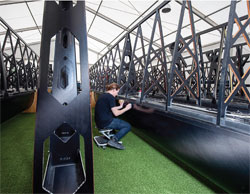 Stripped of their plastic skins (above), the first half dozen wings from the previous Cup teams are painstakingly put into one design trim, including the addition of a battery-powered control system for wing twist. The wing sheet remains a manual winch-driven operation. The AC50s looked light and flighty but the unseen structures were immense: this (below) is a new board cassette being finished off
Stripped of their plastic skins (above), the first half dozen wings from the previous Cup teams are painstakingly put into one design trim, including the addition of a battery-powered control system for wing twist. The wing sheet remains a manual winch-driven operation. The AC50s looked light and flighty but the unseen structures were immense: this (below) is a new board cassette being finished off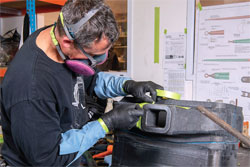
Among their many jobs will be to create a second generation of new wings. ‘The reason we are doing that is to expand the range of the boats,’ elaborates Coutts. ‘It will probably end up being a modular wing with a very light-air solution at 28m, a 24m wing – the same span as in the last Cup – and an 18m wing for heavier conditions. There will be common components to all three wings probably with a modular mid-section that expands the wing out.’ The first heavy-weather wing will be on trial by mid-2019 and could be put into service in Marseille. ‘Which will be handy if we get a Mistral…’
While there might be an upper wind limit initially set in the early 20s, with the new heavy-weather wing and better control systems Coutts reckons they should be able to race in significantly more wind. The ultimate goal is to extend the range up to 30kt of wind speed (which may take a little practice). But out on the racecourse the new F50 will be a step closer to the live TV broadcaster’s dream of having boats that can race almost regardless of the conditions, leaving no embarrassing holes in their programming.
Like America’s Cup 35 in 2017, SailGP is a made-for-TV product including the ultra-short races of typically 20 minutes, run usually from 1600 on. However, while it is tempting to imagine the TV offering will just be more of what we saw in Bermuda, Coutts says this isn’t the case.
This time they have employed a new production company in Whisper Films who are best known for their work in Formula 1 (the company’s founders include TV sports presenter Jake Humphrey and former F1 driver David Coulthard).
Drones are set to take cameras to places they’ve never been before, says Coutts. He imagines one hovering at masthead height during a close cross. ‘They would be pretty spectacular images. Drones will dramatically improve the production.’
Stan Honey’s Liveline ‘increased reality graphics’ has also been upgraded and Coutts expects to see increased use of split screens, the ability to ghost one image over another to compare mark roundings, and increased use of replays. ‘That will enable us to increase the storytelling element between the races with a lot more in-depth analysis.’
Plus this time there is no secrecy, so TV and media will be able to mine all of the data streamed from the boats. ‘We can drill into why one helmsman is out - performing another,’ observes Coutts. ‘Perhaps it is the way they are steering or controlling the boat – we will have that data and now we will be able to share it.’
In addition, borrowing from F1, each team will have its own booth ashore where two coaches will reside during racing. The coaches will also get the full data stream off the boats to analyse and at specific times during the racing will be allowed to communicate with their crew on an open channel for the audience to share.
‘For example, they might tell them to use different settings,’ says Coutts. And of course this live coach-to-driver comms can be used as another broadcast ingredient. ‘It will definitely give viewers a greater appreciation of what they are seeing in terms of the performance differences.’
All of the television will be produced remotely in a London studio. ‘That gives us the capability to put up graphics instantaneously in the language of the nation we are broadcasting to.
‘For example, if a Chinese broadcaster wants us to put Chinese graphics over a Liveline offering, then we can do it.’
Overseeing the racing will be familiar figures in regatta director Iain Murray while Richard Slater will be chief umpire and chairman of racing rules. As expected, SailGP racing will harness electronic race management as used in the two Ellison-era America’s Cups, including course boundaries and booth-based umpires on shore.
SailGP is now being rapidly unveiled throughout the world. While commercially backed sailing is not in an especially buoyant position at present, perhaps this is the shot in the arm it needs.
Hats off to Coutts and Ellison for their sterling efforts – and persistence – at trying to make this work.
Click here for more information on SailGP »
We invite you to read on and find out for yourself why Seahorse is the most highly-rated source in the world for anyone who is serious about their racing.
To read on simply SIGN up NOW
Take advantage of our very best subscription offer or order a single copy of this issue of Seahorse.
Online at:
www.seahorse.co.uk/shop and use the code TECH20
Or for iPad simply download the Seahorse App at the iTunes store


